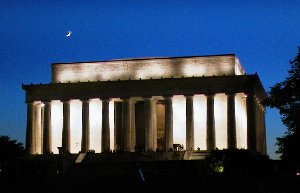The Lincoln Memorial
Our licensed, professional tour guides will take you to the west end of the National Mall for a tour of The Lincoln Memorial. Pictures and video of this incredible monument do not compare to the majestic experience of visiting this popular DC Attraction. You will remember the experience for a lifetime.
 From inside of this gracefully designed neoclassical structure, a “larger than life” statue of President Lincoln sitting in a chair overlooks the National Mall Reflecting Pool; with a breathtaking view of the Washington Monument and the United States Capitol Building. This ingeniously sculpted memorial is a true testament to the patriotism, loyalty, and freedom felt by the supporters and successors of our 16th President of The United States of America, Abraham Lincoln.
From inside of this gracefully designed neoclassical structure, a “larger than life” statue of President Lincoln sitting in a chair overlooks the National Mall Reflecting Pool; with a breathtaking view of the Washington Monument and the United States Capitol Building. This ingeniously sculpted memorial is a true testament to the patriotism, loyalty, and freedom felt by the supporters and successors of our 16th President of The United States of America, Abraham Lincoln.
Lot Flannery sculpted the first statue of President Lincoln which stood in front of the District of Columbia City Hall. On April 15, 1868, the third anniversary of President Lincoln’s assassination, the statue was unveiled in a dedication ceremony by President Lincoln’s successor, President Andrew Johnson.
In the year 1867, Congress passed the first bill to incorporate a commission for the construction of a monument in President Lincoln’s honor, but never received sufficient subscriptions to begin the project. Between the years 1901 and 1908, five separate bills for the incorporation of a new Lincoln Memorial Commission were proposed and defeated. The sixth bill was introduced and passed on December 13, 1910. President William H. Taft was appointed President of The Lincoln Memorial Commission. In the year 1913, the construction project moved forward after receiving Congressional approval on the commission’s choice of location and design. The Architect’s (Henry Bacon) Greek temple design was rejected by those who considered it too flamboyant to represent President Lincoln’s humble demeanor, but construction began as planned in March 1914. The memorial was completed and dedicated by Commission President William H. Taft (then Chief Justice of the United States) on May 30, 1922.
Henry Bacon’s Greek Temple design of The Lincoln Memorial was inspired by his desire to honor the first democratic society of Ancient Greece. The thirty-six (36) columns represent the thirty-six (36) states that formed The United States of America during that time, and each column is inscribed with the name of a state. Inside of the memorial is an entrance hall (with the statue of President Lincoln) that connects the north and south chambers.
Artist, Daniel Chester French sculpted the nineteen feet (19ft) (5.8m) statue of President Lincoln which was completed in just over four (4) years. In the South Chamber you can see the sixteenth (16th) President’s famous Gettysburg Address carved into the wall. Artist, Jules Guerin illustrated the inscription with a mural of an angel with two slaves who were freed by the emancipation. The North Chamber contains an inscription of President Lincoln’s second inaugural address, which is illustrated by a “Jules Guerin” mural of the same angel uniting the north and south when the Civil War ends. In these two unforgettable speeches President Lincoln expressed his beliefs that all men were created equal regardless of skin color, as well as his determination to reunite our nation and free African Americans.
Approximately 100 years after the Gettysburg Address was delivered by Lincoln, Dr. Martin Luther King, Jr., stood on the steps of the Lincoln Memorial and delivered his famous “I Have a Dream” speech to a crowd around the reflecting pool. When you visit the Lincoln Memorial on your DC It All! Tour, your guide will show you the plaque that marks the spot where MLK stood as he delivered one of the most important speeches in history.
The Lincoln Memorial has since been proudly recognized as a symbol of American freedom and equality. The great monument is also known around the world as the site of many equal rights movements, speeches, and protests.
– Written by Patrice Morton
